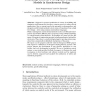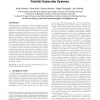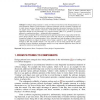77 search results - page 12 / 16 » Illustrating how mechanical assemblies work |
FM
1999
Springer
14 years 21 days ago
1999
Springer
Support for system speci cation in terms of modelling and simulation environments has become a common practice in safety-critical applications. Also, a current trend is the automat...
DEBS
2010
ACM
14 years 10 days ago
2010
ACM
Publish/subscribe systems are used increasingly often as a communication mechanism in loosely-coupled distributed applications. With their gradual adoption in mission critical are...
CANDT
2009
14 years 10 days ago
2009
The aim of the paper is twofold: i) understanding how to provide additional information that is reflective of current organizational context in knowledge production and use; ii) p...
HOST
2009
IEEE
14 years 9 days ago
2009
IEEE
A PUF or Physical Unclonable Function is a function that is embodied in a physical structure that consists of many random uncontrollable components which originate from process var...
COMPUTER
2006
13 years 8 months ago
2006
: In software design, laziness is a virtue: it's better to reuse than to redo. Design patterns are a good illustration. Patterns, a major advance in software architecture, pro...



